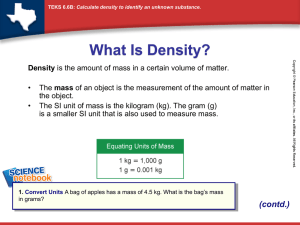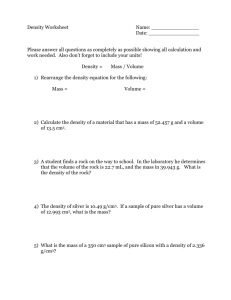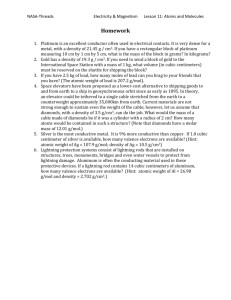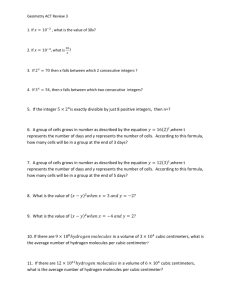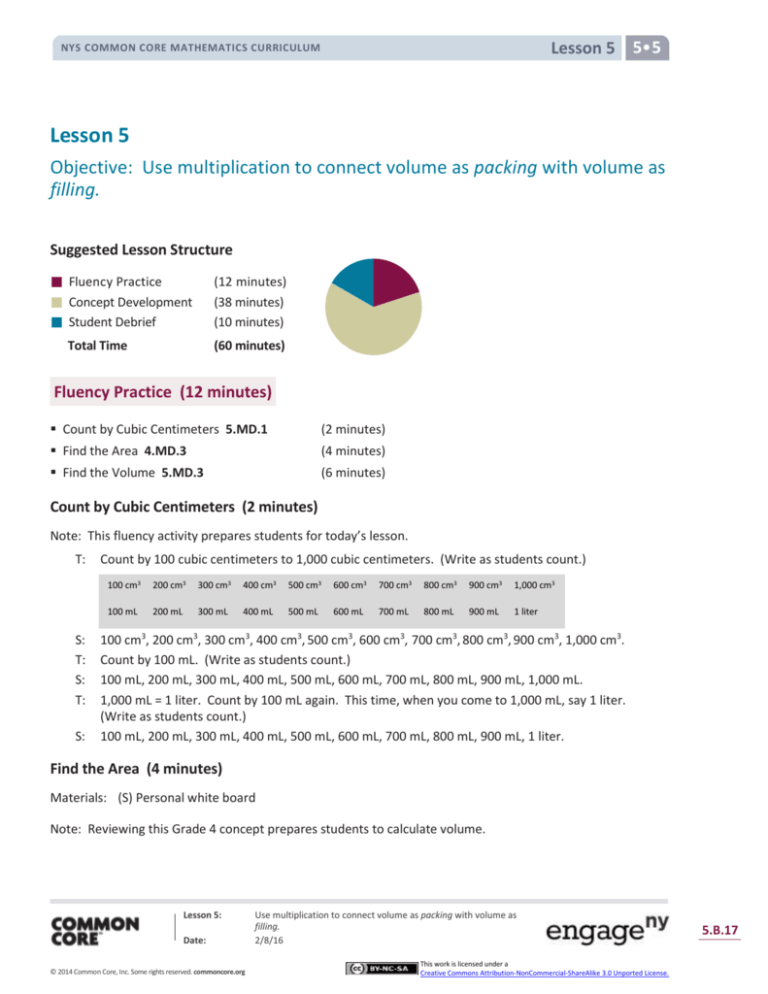
Lesson 5 5•5
NYS COMMON CORE MATHEMATICS CURRICULUM
Lesson 5
Objective: Use multiplication to connect volume as packing with volume as
filling.
Suggested Lesson Structure
Fluency Practice
Concept Development
Student Debrief
(12 minutes)
(38 minutes)
(10 minutes)
Total Time
(60 minutes)
Fluency Practice (12 minutes)
Count by Cubic Centimeters 5.MD.1
(2 minutes)
Find the Area 4.MD.3
(4 minutes)
Find the Volume 5.MD.3
(6 minutes)
Count by Cubic Centimeters (2 minutes)
Note: This fluency activity prepares students for today’s lesson.
T:
S:
T:
S:
T:
S:
Count by 100 cubic centimeters to 1,000 cubic centimeters. (Write as students count.)
100 cm3
200 cm3
300 cm3
400 cm3
500 cm3
600 cm3
700 cm3
800 cm3
900 cm3
1,000 cm3
100 mL
200 mL
300 mL
400 mL
500 mL
600 mL
700 mL
800 mL
900 mL
1 liter
100 cm3, 200 cm3, 300 cm3, 400 cm3, 500 cm3, 600 cm3, 700 cm3, 800 cm3, 900 cm3, 1,000 cm3.
Count by 100 mL. (Write as students count.)
100 mL, 200 mL, 300 mL, 400 mL, 500 mL, 600 mL, 700 mL, 800 mL, 900 mL, 1,000 mL.
1,000 mL = 1 liter. Count by 100 mL again. This time, when you come to 1,000 mL, say 1 liter.
(Write as students count.)
100 mL, 200 mL, 300 mL, 400 mL, 500 mL, 600 mL, 700 mL, 800 mL, 900 mL, 1 liter.
Find the Area (4 minutes)
Materials: (S) Personal white board
Note: Reviewing this Grade 4 concept prepares students to calculate volume.
Lesson 5:
Date:
© 2014 Common Core, Inc. Some rights reserved. commoncore.org
Use multiplication to connect volume as packing with volume as
filling.
2/8/16
This work is licensed under a
Creative Commons Attribution-NonCommercial-ShareAlike 3.0 Unported License.
5.B.17
Lesson 5 5•5
NYS COMMON CORE MATHEMATICS CURRICULUM
T:
S:
T:
S:
T:
S:
T:
S:
T:
S:
T:
S:
(Project rectangle with side lengths of 6 cm and 4 cm.) What is the length of the rectangle’s longest
side?
6 cm.
6 cm
What is the length of the rectangle’s shortest
side?
4 cm
4 cm.
9 cm
(Write __ cm × __ cm = __ cm2.) On your
personal white board, write the area of the
rectangle as a multiplication sentence
including the units.
(Write 6 cm × 4 cm = 24 cm2.)
9 cm
(Project a square with a given length of 9 cm.)
Name the shape.
Square.
7 in
3 cm
What is the length of the square’s sides?
9 cm.
(Write __ cm × __ cm = __ cm2.) Write the area of
the square as a multiplication sentence including
12 in
the units.
3 in
7 in
5 in
(Write 9 cm × 9 cm = 81 cm2.)
Continue this process for the other rectangles and squares.
Find the Volume (6 minutes)
Materials: (S) Personal white board
Note: This fluency exercise reviews Lesson 4.
T:
S:
T:
S:
T:
S:
T:
S:
(Project the 4 cm by 5 cm by 2 cm rectangular prism illustrated
at right.) What’s the length of the rectangular prism?
4 cm.
What’s the width?
5 cm.
What’s the height?
2 cm.
(Write __ cm × __ cm × __ cm = __ cm3.) On your personal
white board, calculate the volume.
(Write 4 cm × 5 cm × 2 cm = 40 cm3.)
Repeat this process for the 3 cm by 3 cm by 8 cm rectangular prism.
Lesson 5:
Date:
© 2014 Common Core, Inc. Some rights reserved. commoncore.org
Use multiplication to connect volume as packing with volume as
filling.
2/8/16
This work is licensed under a
Creative Commons Attribution-NonCommercial-ShareAlike 3.0 Unported License.
5.B.18
Lesson 5 5•5
NYS COMMON CORE MATHEMATICS CURRICULUM
T:
S:
T:
S:
T:
S:
(Project the rectangular prism at right.) Say the given area of
the rectangular prism’s front face.
40 ft2.
Say the given length.
7 ft.
(Write V = __ft3.) On your personal white board, calculate the
volume.
(Write V = 280 ft3.)
Repeat this process for the rectangular prism with a face of 12 ft2 and a height of 9 ft.
Concept Development (38 minutes)
Materials: (S) Per group: centimeter cubes, several small
watertight containers (preferably right rectangular
prisms) marked with a horizontal line for measuring,
small pitcher of water, beaker labeled with mL, class
data recording sheet poster, ruler or tape measure,
Problem Set
Note: Because today’s lesson is a hands-on exploration, time
for the Application Problem has been given to the Concept
Development.
Before class, prepare a large poster or sheet for groups to
record their findings. Be sure to use cubes that are denser than
water for the displacement exploration.
Problem 1
Investigate 1 cm3 = 1 mL.
T:
S:
T:
What are some ways that we can determine the
volume of the box you’ve been given using the
materials on your table?
We can pack it with cubes and count. We can pack
the bottom layer and then use the cubes to find how
many layers. We could find the area of any base
and then count the layers. We can measure the
sides and then multiply the three dimensions.
Measure the inside dimensions of your box using the
line that’s drawn as the height, and multiply to find the
volume. Then, confirm the measurement by packing
the box to the line that’s drawn. Record the volume in
cubic centimeters on your Problem Set.
Lesson 5:
Date:
© 2014 Common Core, Inc. Some rights reserved. commoncore.org
NOTES ON
MULTIPLE MEANS
OF REPRESENTATION
AND MATERIALS:
Fancy toothpicks, straight pins, and
some office supplies come in clear
rectangular boxes suitable for this
activity. The horizontal fill line for the
water can be drawn at a height that
will match the number of cubes that
can be packed into the box. If these
are not readily available, small
rectangular breath mint boxes or metal
spice boxes can be used. However,
students may have to estimate if the
corners are rounded. It is best to test
the boxes and volumes before
implementing this lesson.
An alternative approach is to gather a
collection of small gift boxes and use
salt rather than water to fill them.
While salt is not a liquid, it does
behave like one for the purposes of the
first activity.
The second activity must be done with
water and a centimeter cube that will
sink. If a dense cube is not available,
students should use a drinking straw or
coffee stirrer to submerge the cube
completely.
If resources are limited, this may be
done as a demonstration and then as a
center over the course of a few days in
small groups.
Use multiplication to connect volume as packing with volume as
filling.
2/8/16
This work is licensed under a
Creative Commons Attribution-NonCommercial-ShareAlike 3.0 Unported License.
5.B.19
Lesson 5 5•5
NYS COMMON CORE MATHEMATICS CURRICULUM
S:
T:
S:
MP.6
T:
S:
T:
S:
T:
T:
S:
T:
S:
T:
S:
T:
S:
T:
S:
T:
S:
T:
S:
T:
(Work.)
Now, I would like you to find the amount of liquid your container will hold. Any ideas how you
might do this using the materials on your table? Turn and talk.
We could pour in some water and then measure the water with the beaker. We could fill the
container with water and then use a measuring cup to measure the water. That would tell us the
amount it will hold.
What units are used on the beaker?
Milliliters.
Pour the water to the fill line. Then, measure the amount of water by carefully pouring it into the
beaker. Record the liquid volume on your Problem Set. Once your group is done, have a member of
your group record your data onto the class poster.
(Work and record.)
(Circulate, asking students to describe what they’re doing. Encourage use of the terms volume,
capacity, and other unit language.)
Now that we’ve recorded our findings, let’s look at the volume data. What do you notice about the
volume as measured by the cubes and the liquid volume?
They are the same. Our box packed 36 cubes, and it held 36 mL of water. Although our prism
was a different size than the first group’s, our packing and filling was the same. Ours was really
close—just one cubic centimeter more than the milliliters.
What can you say about the relationship of 1 milliliter to 1 cubic centimeter?
They seem to be the same. I think they are equal.
There’s a way we can show that these two measurements are equal. Put water into your beaker to
any measuring point other than the fill line. Be careful to fill it exactly to the line you choose. For
example, you might fill your beaker to 15 mL.
(Pour.)
Now, pour in 1 more milliliter of water, and describe what happens to the water level.
The water went up one more line. The water rose because we put more in.
Record the new amount of water on your Problem Set. What will happen to the water level if we
place 1 cube in the beaker? Tell your partner.
It will go up again. The water will rise because the
NOTES ON
cube pushes some of the water out of the way.
MULTIPLE MEANS
Let’s find out how far the water will rise.
OF ENGAGEMENT:
Place 1 centimeter cube into the water.
When dividing students into groups, be
Describe what happens to your partner.
sure to choose members with different
(Work and discuss.)
strengths. Try to assign tasks such as
How did the water level change?
recorder, builder, pourer, and
measurer.
The water rose. It looks like there’s more water in
the beaker. The water went up 1 mL.
We didn’t actually put more water in, and yet the cube caused a rise in the water level equal to
when we put 1 mL of water in the beaker. From this investigation and from our work with the
boxes, what can we say about the relationship between 1 mL of water and 1 cubic centimeter?
Lesson 5:
Date:
© 2014 Common Core, Inc. Some rights reserved. commoncore.org
Use multiplication to connect volume as packing with volume as
filling.
2/8/16
This work is licensed under a
Creative Commons Attribution-NonCommercial-ShareAlike 3.0 Unported License.
5.B.20
Lesson 5 5•5
NYS COMMON CORE MATHEMATICS CURRICULUM
S:
T:
They are equal. I know they are equal because I measured my box and got the same number of
cubes as milliliters. I know they are equal because one cube made the water go up 1 milliliter.
Yes. We have seen that 1 cubic centimeter = 1 mL. (Write 1 cm3 = 1 mL on the board.) This is an
important relationship that will help us solve problems.
Problem 2
A rectangular tank measures 30 cm by 20 cm by 40 cm. How many milliliters of water are in the tank when it
is full? How many liters is that?
T:
S:
T:
S:
T:
S:
T:
S:
Let’s use what we’ve learned about volume as filling to solve
this problem. We need to find the volume of the water in the
tank. What do we know about the tank that can help us?
40 cm
We know the size of the tank. Since the water is filled to the
top, the volume of the tank will be the same as the volume of
the water.
20 cm
Find the volume of the tank.
30 cm
(Work to find 24,000 cubic centimeters.)
We discovered today that 1 cubic centimeter is equal to 1 mL. Since this is true, how many milliliters
of water are in the tank when it is full?
24,000 mL.
How many liters is that?
24 liters.
Problem 3
a. A small fish tank is filled to the top with water. If the tank measures
15 cm by 10 cm by 10 cm, what is the volume of water in the tank?
Express your answer in mL.
b. After a week, water evaporates out of the tank, so the water is 9 cm
high. What is the volume of the water in the tank?
T:
S:
T:
S:
T:
10 cm
10 cm
15 cm
(Project Problem 3(a) and the accompanying image onto the
board.) Using what we’ve talked about today, turn and talk to
your partner, and find the volume of water in the tank in cubic
centimeters and in milliliters.
All we need to do is multiply the sides because the water is all the way to the top. Since the
water fills the whole tank, we can just multiply 15 × 10 × 10. That’s 1,500 cubic centimeters. It’s
easy to find the volume. It’s 1,500 cubic centimeters. We have to say it in milliliters. That’s exactly
the same number, so it’s 1,500 mL.
(Project Problem 3(b).) Let’s imagine that some of the water evaporated out of the tank. Now, the
water is only 9 cm deep. Does this change the height of the tank? Why or why not?
No, because the tank doesn’t change size.
Does this change the area of the bottom of the tank?
Lesson 5:
Date:
© 2014 Common Core, Inc. Some rights reserved. commoncore.org
Use multiplication to connect volume as packing with volume as
filling.
2/8/16
This work is licensed under a
Creative Commons Attribution-NonCommercial-ShareAlike 3.0 Unported License.
5.B.21
Lesson 5 5•5
NYS COMMON CORE MATHEMATICS CURRICULUM
S:
T:
S:
T:
S:
T:
S:
T:
S:
No, the tank is still the same size.
Will the volume of the water change? Why or why
not?
The volume in the tank will be less because some of
the water is gone. The water won’t be as high.
The water level will go down by 1 cm, so that’s like
pouring out a layer of 15 by 10 centimeters.
Find the volume of the water in the tank now. Turn
and talk.
The bottom of the tank is the same, so the water is
spread out on the bottom the same way as before.
The only thing that is different is the height of the
water. I’ll multiply 15 and 10 and then multiply by 9.
That’s 1,350 cubic centimeters of water. The part of
the water that is gone is 15 × 10 × 1. That’s 150 cubic
centimeters. I can subtract that from 1,500. That will
be 1,350 cubic centimeters still in the tank.
What is the volume of the water in the tank now?
1,350 cubic centimeters.
Express that in milliliters.
1,350 mL.
NOTES ON
MULTIPLE MEANS
OF ENGAGEMENT:
While the relationship of 1 cm3 = 1 mL
seems a simple one numerically, the
concept behind this relationship—that
of volume as filling, as well as packing
(especially when comparing a
rectangular container to a cylindrical
one)—is more complex. Be sure to
offer many opportunities for students
to encounter this concept beyond
today’s lesson. Ask often if an amount
of liquid will fit into rectangular
containers and how it might be
confirmed without pouring.
Problem Set (10 minutes)
Students should do their personal best to complete the
Problem Set within the allotted 10 minutes. For some
classes, it may be appropriate to modify the assignment by
specifying which problems they work on first. Some
problems do not specify a method for solving. Students
should solve these problems using the RDW approach
used for Application Problems.
Student Debrief (10 minutes)
Lesson Objective: Use multiplication to connect volume
as packing with volume as filling.
The Student Debrief is intended to invite reflection and
active processing of the total lesson experience.
Invite students to review their solutions for the Problem Set. They should check work by comparing answers
with a partner before going over answers as a class. Look for misconceptions or misunderstandings that can
be addressed in the Debrief. Guide students in a conversation to debrief the Problem Set and process the
lesson.
Lesson 5:
Date:
© 2014 Common Core, Inc. Some rights reserved. commoncore.org
Use multiplication to connect volume as packing with volume as
filling.
2/8/16
This work is licensed under a
Creative Commons Attribution-NonCommercial-ShareAlike 3.0 Unported License.
5.B.22
Lesson 5 5•5
NYS COMMON CORE MATHEMATICS CURRICULUM
Any combination of the questions below may be used to lead the discussion.
Make a real life connection for students by
discussing the use of cubic centimeters and the
term cc’s in medical applications. Medicines,
intravenous fluids, and injections are often
ordered in cc’s rather than mL. Students may not
be aware that this is a cubic centimeter,
equivalent to 1 milliliter.
Problem 6 describes the height of the water using
the word depth. Discuss the connection between
these two terms. How is height like depth?
When might you use the word height to describe
a figure, and when might depth be more
appropriate? Can the words be used
interchangeably? (Have students rephrase
problems from the Problem Set to test.) English
language learners especially will benefit from
such a discussion.
Problem 7 asks students to extend their
knowledge of cubic centimeters and milliliters to
liters. Allow students to work together to think
through this task if necessary and then explain
their thinking to another partner group. Discuss
other connections as well. If 1 cubic centimeter is equal to 1 milliliter, to what liquid measure is 1
cubic meter equivalent? How could you find out? (Students can draw to investigate using 100 cm =
1 m.) Building a cubic container from meter sticks in the classroom will help students visualize the
actual volume of 1 kiloliter. They might also imagine pouring 1,000 liter bottles of water or 500 2liter soft drinks into that single container.
Ask students to generate as many rectangular prisms with whole number sides as they can that
would hold 1 liter of liquid. Although the dimensions will all be factors of 1,000, the shapes of the
containers may be drastically different. Students might even be encouraged to draw the containers
on isometric dot paper for comparison. Ask: What do the sides of all these containers have in
common? (All are factors of 1,000.) Because they all have the same factors, are they all the same
shape? Why or why not?
Exit Ticket (3 minutes)
After the Student Debrief, instruct students to complete the Exit Ticket. A review of their work will help with
assessing students’ understanding of the concepts that were presented in today’s lesson and planning more
effectively for future lessons. The questions may be read aloud to the students.
Lesson 5:
Date:
© 2014 Common Core, Inc. Some rights reserved. commoncore.org
Use multiplication to connect volume as packing with volume as
filling.
2/8/16
This work is licensed under a
Creative Commons Attribution-NonCommercial-ShareAlike 3.0 Unported License.
5.B.23
Lesson 5 Problem Set 5•5
NYS COMMON CORE MATHEMATICS CURRICULUM
Name
Date
1. Determine the volume of two boxes on the table using cubes, and then confirm by measuring and
multiplying.
Box
Number
Number of Cubes
Packed
Length
Measurements
Width
Height
Volume
2. Using the same boxes from Problem 1, record the amount of liquid that your box can hold.
Box
Number
Liquid the Box Can
Hold
mL
mL
3. Shade to show the water in the beaker.
mL
10
mL
10
mL
10
9
9
9
8
8
8
7
7
7
6
5
6
5
6
5
4
4
4
3
3
3
2
2
2
1
1
1
At first:
After 1 mL water added:
_________ mL
_________ mL
Lesson 5:
Date:
© 2014 Common Core, Inc. Some rights reserved. commoncore.org
After 1 cm cube added:
_________ mL
Use multiplication to connect volume as packing with volume as
filling.
2/8/16
This work is licensed under a
Creative Commons Attribution-NonCommercial-ShareAlike 3.0 Unported License.
5.B.24
Lesson 5 Problem Set 5•5
NYS COMMON CORE MATHEMATICS CURRICULUM
4. What conclusion can you draw about 1 cubic centimeter and 1 mL?
5.
The tank, shaped like a rectangular prism, is filled to the top with water.
13 cm
10 cm
8 cm
1 L --------------------500 mL ---------------------
Will the beaker hold all the water in the tank? If yes, how much more will the beaker hold? If no, how
much more will the tank hold than the beaker? Explain how you know.
6. A rectangular fish tank measures 26 cm by 20 cm by 18 cm.
The tank is filled with water to a depth of 15 cm.
a. What is the volume of the water in mL?
b. How many liters is that?
c. How many more mL of water will be needed to fill the tank to the top? Explain how you know.
7. A rectangular container is 25 cm long and 20 cm wide. If it holds 1 liter of water when full, what is its
height?
Lesson 5:
Date:
© 2014 Common Core, Inc. Some rights reserved. commoncore.org
Use multiplication to connect volume as packing with volume as
filling.
2/8/16
This work is licensed under a
Creative Commons Attribution-NonCommercial-ShareAlike 3.0 Unported License.
5.B.25
Lesson 5 Exit Ticket 5•5
NYS COMMON CORE MATHEMATICS CURRICULUM
Name
Date
15 cm
5 cm
3 cm
250 mL ------200 mL ------150 mL ------100 mL ------50 mL -------
a. Find the volume of the prism.
b. Shade the beaker to show how much liquid would fill the box.
Lesson 5:
Date:
© 2014 Common Core, Inc. Some rights reserved. commoncore.org
Use multiplication to connect volume as packing with volume as
filling.
2/8/16
This work is licensed under a
Creative Commons Attribution-NonCommercial-ShareAlike 3.0 Unported License.
5.B.26
Lesson 5 Homework 5•5
NYS COMMON CORE MATHEMATICS CURRICULUM
Name
Date
1. Johnny filled a container with 30 centimeter cubes. Shade the beaker to
show how much water the container will hold. Explain how you know.
100 mL -------80 mL --------60 mL --------40 mL --------20 mL ---------
2. A beaker contains 250 mL of water. Jack wants to pour the water into a container that will hold the
water. Which of the containers pictured below could he use? Explain your choices.
C
5 cm
A
2 cm
25 cm
6 cm
B
12 cm
Area =
75 cm2
D
12 cm
Area =
20 cm2
3 cm
E
12 cm
3 cm
5 cm
3. On the back of this paper, describe the details of the activities you did in class today. Include what you
learned about cubic centimeters and milliliters. Give an example of a problem you solved with an
illustration.
Lesson 5:
Date:
© 2014 Common Core, Inc. Some rights reserved. commoncore.org
Use multiplication to connect volume as packing with volume as
filling.
2/8/16
This work is licensed under a
Creative Commons Attribution-NonCommercial-ShareAlike 3.0 Unported License.
5.B.27

